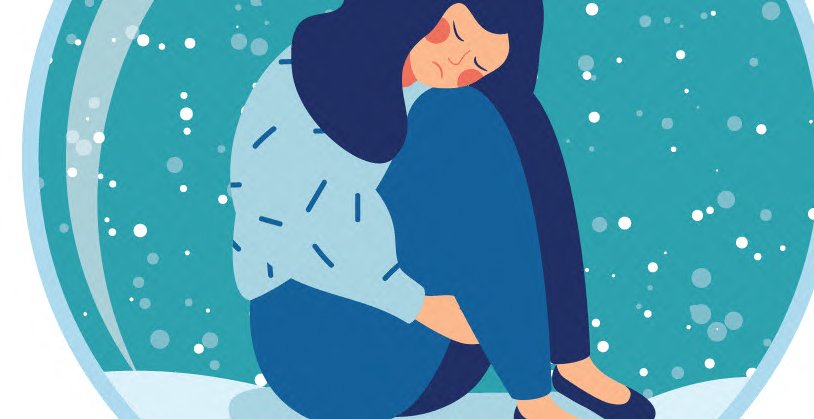Nobody likes the short, colder days of the winter season. The concept that our mood fluctuates with the seasons has been proposed for many centuries. For individuals suffering with chronic pain, it can be even more of a problem. As we slowly move away from the dreary days of winter, we are hopeful of being re-energised with the arrival of spring. Unfortunately, for individuals with chronic pain with conditions such as fibromyalgia, chronic fatigue syndrome or chronic myofascial pain, they might take longer than most to recover from this seasonal dip in energy or increase in pain symptoms.
Chronic pain is not the only condition to show a seasonal variation. Rosenthal and colleagues performed a series of bright-light therapy trials in 1980 and coined the term ‘seasonal affective disorder’ (SAD) and new interest in the condition was generated.
Estimates of the incidence of SAD in the general population suggest about 5 per cent of individuals experience SAD annually. The true value of SAD in those with chronic pain is unknown, but given that one-in-five individuals have chronic pain, there is likely to be a significant overlap. When you consider the number of individuals with fibromyalgia, chronic myofascial pain or chronic fatigue syndrome, it is easy to imagine the impact the presence of SAD can have on those with chronic pain.
What is SAD?
Features of SAD include being irritable, exhausted, distracted, and withdrawn. These are features common to many chronic pain suffers and it might be reasonable to attribute them to a ‘flare-up’ of the pain. But as clinicians, we need to be aware that we may be dealing with something else and not just an incidental increase in the chronic pain condition. If an individual reports low energy, weight gain and increased sleep, then you need to consider the possibility of concurrent SAD. While the diagnosis is made primarily on clinical grounds, SAD should be considered in all people with recurrent affective disorders.
In addition to a full history, there are several questionnaires that have been designed to aid diagnosis. The Seasonal Pattern Assessment Questionnaire (SPAQ) is brief and is the most widely used.
Epidemiology and aetiology
It appears that SAD lies on a spectrum that can range between ‘normal’ seasonal changes, to actual SAD. For example, two large community prevalence studies in the UK estimated 3.5 per cent (in Aberdeen) and 2.4 per cent (in North Wales) of adults to be affected to a level of clear clinical significance. Epidemiological studies in the US estimate that its prevalence can range from 1.4 per cent of the adult population in Florida, to 9.7 per cent in New Hampshire.
SAD is four times more common in females of reproductive age. Individuals with a history (either personal or familial) of depression or bipolar disorder, as well as those who live far from the equator, seem to have a higher risk.
Interestingly, there is a summer version of SAD as well. This is characterised by restlessness, a decline in appetite, and insomnia. SAD is relatively rare in children. In the older adult population, the ratio between males and females with SAD tends to equalise.
Aetiological theories of SAD include:
a) Exposure to daylight or photoperiods: Indicated by the seasonal nature of SAD and effects of photoperiods in other mammals and the effects of latitude of residence/moving away from the equator. There is some evidence that SAD sufferers are less exposed to natural light and that symptom fluctuations with changes in weather occur.
b) Melatonin levels: There are possibly greater seasonal fluctuations in melatonin among SAD sufferers.
c) Monoamines: Indicated by seasonal fluctuations in serotonin (or metabolites) in platelets, cerebrospinal fluid and post-mortem brains. Tryptophan depletion and catecholamine depletion provoke relapse in SAD patients successfully treated with light therapy, and selective serotonin reuptake inhibitors (SSRI) antidepressants are of established efficacy.
Treatment
Recognising the symptoms of SAD can be very important because it can direct the treatment options. Firstly, if SAD is present and you are satisfied that it is not ‘just a flare-up in chronic pain’, then increasing the pain medication is unlikely to help the individuals. Secondly, because you can treat SAD with some simple steps, it is equally important not to ignore some practical treatment options.
Effective treatment options for SAD include:
a) Light therapy (or phototherapy)
For many, this is the first-line of treatment for SAD. After waking up in the morning, patients sit approximately 18 inches from a light box — an illuminated device that should emit 10,000 lux of strong white light and very little ultraviolet (UV) light — for 30-to-45 minute sessions. A two-week course of treatment is usually effective.
Initially, 5,000 lux hours/day is recommended. This is most effective if given in the morning, but time may be ‘topped-up’ in the afternoon if this is practical. Bright-light treatment should not be taken at night, as it can induce insomnia. These portable devices are readily available to purchase and range in price from €35-to-50.
Side-effects are uncommon and generally well tolerated. The most common adverse effects are headache and blurred vision. Advice about not looking continuously and directly into the light often is beneficial. There are no known cases of ocular damage with bright-light therapy.
There are alternatives to light boxes. In particular, dawn-simulating alarm clocks have been shown to be effective and may facilitate treatment adherence. Some individuals find that having a winter sunshine holiday is enough to offset the SAD.
b) Medication
As with all medication there are advantages and disadvantages and sometimes a balance has to be found that suits each individual’s needs. Duloxetine is an antidepressant included in the pharmacological class of serotonin-norepinephrine reuptake inhibitors (SNRIs) approved for the treatment of major depressive disorder, generalised anxiety disorder, diabetic peripheral neuropathic pain, fibromyalgia, and chronic musculoskeletal pain. There is now some evidence that it may be an effective treatment for mood spectrum disorders (Frontiers Psychiatry 2019).
Other antidepressants are also used to treat SAD; popular options include SSRIs, particularly fluoxetine and bupropion.
As with any medication targeting moods it is important to consider the overall well-being of the individual before committing to this option. It may be possible to use this style of medication to help an individual with chronic pain get over the seasonal issues but it may take a few weeks for the medication to help so it needs to be considered in advance.
c) Vitamin D
Vitamin D is produced by the body after exposure to the sun, therefore people tend to have lower vitamin D levels in the winter. Supplementation of this vitamin (either through foods or supplements) could help alleviate SAD symptoms. As it has also become easier to measure vitamin D levels it may be of benefit to measure a baseline level and monitor the pattern in your patients with chronic pain.
There have not been many studies researching vitamin D’s impact on SAD; some researchers have found a link between low levels of vitamin D in the blood and depression. Low vitamin D levels have been reported in chronic pain patients including fibromyalgia and chronic pain syndromes. There has been some interesting recommendations, such as Stewart B Leavitt writing in Practical Pain Management, who feels that a “vitamin D supplement may help patients cope with chronic pain”. This approach is simple and practical. Taking vitamin D as a single tablet or in conjunction with a multivitamin is a practical step we could all consider.
d) Melatonin:
Researchers published in the Proceedings of the National Academy of Science have found that low-dose melatonin, a naturally occurring brain substance might be another way to treat SAD. It is proposed SAD stems from “a mismatch” between your circadian rhythms and your sleep/wake cycle (ie, the cycle dictated by your alarm clock).
The time and dose used is important. Lewy et al recommend taking around 0.5mg of melatonin, which is just above what the body naturally produces at night, but about 1/10 the normal dose sold in stores seems adequate. Some individuals who are particularly susceptible to the sleep-inducing effects of melatonin – even at low doses – shouldn’t drive after taking the supplement. Taking the dose in the late afternoon might be the best option.
e) Cognitive behavioural therapy (CBT):
This form of psychotherapy involves the therapist working with the individual to help the sufferer identify and understand ways of thinking that may be obstacles to improving their mood, thereby increasing the ability of the person with SAD to alleviate symptoms. In CBT, trained clinicians encourage patients to challenge unhelpful thought patterns and become more active and engaged with others, as well as plan for future SAD episodes. This technique is practical and offers the individual the ability to respond to their symptoms in a timely fashion.
f) Physical activity:
Exercise is always to be recommended. Physical fitness lends us to produce natural endorphins (pain-relieving hormones) that can help boost moods. In fact, a lack of exercise could be one reason for a possible link between chronic pain and SAD symptoms. Physical activity is recommended for the relief of many pains from lower back pain to fibromyalgia to arthritis.
With the long dark evenings people tend to be more sedentary during the winter, and that can lead to feelings of low self-confidence and unhappiness. In an English study with almost 2,500 people, respondents were most likely to experience pain in the winter.
There are many ways to encourage individuals to be active even during the winter months: Follow an exercise class online or on television, meet a friend for indoor tennis or a yoga class, incentivise things by setting up – and paying for – a gym membership. The importance of exercise cannot be overstated especially as we turn into the spring. Adding physical activity to your treatment prescription at this time of year for your patients will offer them the best opportunity to control the symptoms of SAD and chronic pain.
Overall
If an individual with a chronic pain condition, such as fibromyalgia, presents with an increase in tiredness, irritability or the altered mood and sleeping pattern it may not just be a ‘flare up’ of their chronic pain condition that is to blame. A diagnosis of SAD should be considered and it can be very reassuring that it is not just their chronic pain but a separate condition. By recognising the concurrent presence of SAD in those with chronic pain you may be providing very effective pain management treatment.
Further reading on request













Leave a Reply
You must be logged in to post a comment.